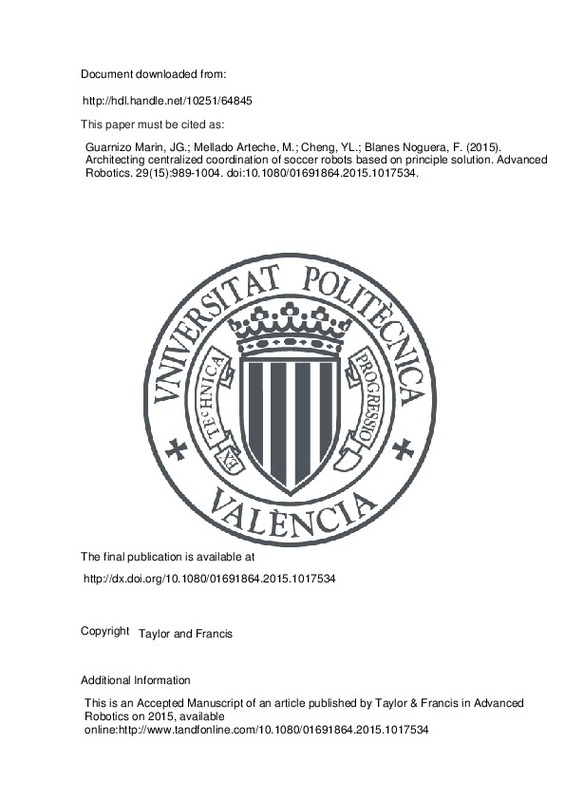Farinelli, A., Iocchi, L., & Nardi, D. (2004). Multirobot Systems: A Classification Focused on Coordination. IEEE Transactions on Systems, Man and Cybernetics, Part B (Cybernetics), 34(5), 2015-2028. doi:10.1109/tsmcb.2004.832155
Tews, A., & Wyeth, G. (2000). MAPS: a system for multi-agent coordination. Advanced Robotics, 14(1), 37-50. doi:10.1163/156855300741429
Stulp, F., Utz, H., Isik, M., & Mayer, G. (2010). Implicit Coordination with Shared Belief: A Heterogeneous Robot Soccer Team Case Study. Advanced Robotics, 24(7), 1017-1036. doi:10.1163/016918610x496964
[+]
Farinelli, A., Iocchi, L., & Nardi, D. (2004). Multirobot Systems: A Classification Focused on Coordination. IEEE Transactions on Systems, Man and Cybernetics, Part B (Cybernetics), 34(5), 2015-2028. doi:10.1109/tsmcb.2004.832155
Tews, A., & Wyeth, G. (2000). MAPS: a system for multi-agent coordination. Advanced Robotics, 14(1), 37-50. doi:10.1163/156855300741429
Stulp, F., Utz, H., Isik, M., & Mayer, G. (2010). Implicit Coordination with Shared Belief: A Heterogeneous Robot Soccer Team Case Study. Advanced Robotics, 24(7), 1017-1036. doi:10.1163/016918610x496964
Guarnizo, J. G., Mellado, M., Low, C. Y., & Aziz, N. (2013). Strategy Model for Multi-Robot Coordination in Robotic Soccer. Applied Mechanics and Materials, 393, 592-597. doi:10.4028/www.scientific.net/amm.393.592
Riley, P., & Veloso, M. (2002). Recognizing Probabilistic Opponent Movement Models. Lecture Notes in Computer Science, 453-458. doi:10.1007/3-540-45603-1_59
Ros, R., Arcos, J. L., Lopez de Mantaras, R., & Veloso, M. (2009). A case-based approach for coordinated action selection in robot soccer. Artificial Intelligence, 173(9-10), 1014-1039. doi:10.1016/j.artint.2009.02.004
Atkinson, J., & Rojas, D. (2009). On-the-fly generation of multi-robot team formation strategies based on game conditions. Expert Systems with Applications, 36(3), 6082-6090. doi:10.1016/j.eswa.2008.07.039
Costelha, H., & Lima, P. (2012). Robot task plan representation by Petri nets: modelling, identification, analysis and execution. Autonomous Robots, 33(4), 337-360. doi:10.1007/s10514-012-9288-x
Abreu, P. H., Silva, D. C., Almeida, F., & Mendes-Moreira, J. (2014). Improving a simulated soccer team’s performance through a Memory-Based Collaborative Filtering approach. Applied Soft Computing, 23, 180-193. doi:10.1016/j.asoc.2014.06.021
Duan, Y., Liu, Q., & Xu, X. (2007). Application of reinforcement learning in robot soccer. Engineering Applications of Artificial Intelligence, 20(7), 936-950. doi:10.1016/j.engappai.2007.01.003
Hwang, K.-S., Jiang, W.-C., Yu, H.-H., & Li, S.-Y. (2011). Cooperative Reinforcement Learning Based on Zero-Sum Games. Mobile Robots - Control Architectures, Bio-Interfacing, Navigation, Multi Robot Motion Planning and Operator Training. doi:10.5772/26620
Gausemeier, J., Dumitrescu, R., Kahl, S., & Nordsiek, D. (2011). Integrative development of product and production system for mechatronic products. Robotics and Computer-Integrated Manufacturing, 27(4), 772-778. doi:10.1016/j.rcim.2011.02.005
Klančar, G., Zupančič, B., & Karba, R. (2007). Modelling and simulation of a group of mobile robots. Simulation Modelling Practice and Theory, 15(6), 647-658. doi:10.1016/j.simpat.2007.02.002
Gausemeier, J., Frank, U., Donoth, J., & Kahl, S. (2009). Specification technique for the description of self-optimizing mechatronic systems. Research in Engineering Design, 20(4), 201-223. doi:10.1007/s00163-008-0058-x
[-]







![[Cerrado]](/themes/UPV/images/candado.png)


